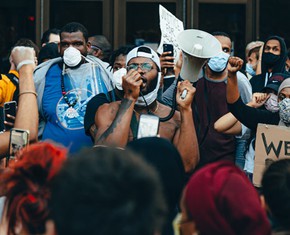The views expressed in our content reflect individual perspectives and do not represent the authoritative views of the Baha'i Faith.
In one of his stand-up sets, the comedian George Lopez hilariously asked: “Where is Caucasia, anyway? Maybe somewhere north of Hispania?”
I remembered Lopez’s line the other day, when I had to fill out a demographic form. You know the ones: check the box that describes your “race.” (There was no box for “human.”)
The box I checked, which said “Caucasian or white,” made me wonder why we still use these antiquated old racist terms.
For example—I have two good friends, one from Italy and another whose family originated in northern Africa. The Italian always checks the “Caucasian” box—even though his skin color is much, much darker than the one who usually checks the “black” or “African” category.
The Baha’i teachings say that these old racial divisions have no basis in reality:
In the sight of God there is no distinction between whites and blacks; all are as one. Anyone whose heart is pure is dear to God—whether white or black, red or yellow. Among the animals colors exist. The doves are white, black, red, blue; but notwithstanding this diversity of color they flock together in unity, happiness and fellowship, making no distinction among themselves, for they are all doves. Man is intelligent and thoughtful, endowed with powers of mind. Why, then, should he be influenced by distinction of color or race, since all belong to one human family? There is no sheep which shuns another as if saying, “I am white, and you are black.” They graze together in complete unity, live together in fellowship and happiness. How then can man be limited and influenced by racial colors? The important thing is to realize that all are human, all are one progeny of Adam. Inasmuch as they are all one family, why should they be separated? – Abdu’l-Baha, The Promulgation of Universal Peace, pp. 425-426.
So if you’re white—a “Caucasian,” to use the word on the form I filled out—or even if you’re not, do you know where the term came from? Originally, of course, it described people from the Caucasus mountains, the geographic region south of modern-day Russia (whose inhabitants, ironically, were mostly Sunni Muslims). But the use of the term to describe white-skinned people in general was coined by a German philosopher named Christoph Meiners in 1785, in his book The Outline of History of Mankind. Meiners believed that “Kaukasischens” were the “most beautiful race”—“handsome and white,” he called them—and the “other race,” who he called the “Mongolian,” were “ugly and dark.”

Mount Kazbek in the Caucasus Mountains.
Meiners, like the French naturalist Julien-Joseph Virey and many other early theorists, was a polygenist—a supporter of the idea that people with different skin colors actually had different genetic origins. Polygenists believed in a multiplicity of races, all defined by color. The Biblical Adam and Eve were white, they insisted—and all other dark-skinned “races” came from some other progeny.
A contemporary of Meiners, Johann Friedrich Blumenbach, another German naturalist and professor of medicine, gave the word Caucasian a much larger audience when he took actual measurements of the crania of sixty people with different skin colors. Blumenbach’s best-known book, On the Natural Variety of Mankind, identified five human “races” based on his cranial measurements and on color: Caucasians, or the “white race,” Mongoloid, or the “yellow race,” Malayan, the “brown race,” Ethiopian, or the “black race,” and American, or the “red race.” Later, this color-based racial typology got shortened to three categories: “Caucasian,” “Mongoloid” and “Negroid.” Millions of children once learned these terms in school, convinced that they had some scientific merit or evidence—which they definitely did not. Amazingly, without any scientific backing, we still use these terms today.
Although Johann Blumenbach was a monogenist—as all modern genetic scientists are—he still believed in the “degenerative hypothesis”—that darker skin meant a degeneration had occurred, either from poor diet or excessive exposure to the sun. Adam and Eve, he argued, were Caucasians—and therefore the “original stock” of humanity. His conclusions, and the similar theories of many other naturalists of the period, are all called “scientific racism” now, because they tried to use a thin veneer of unproven science to support racist theories.
Today in the 21st Century, most people intellectually understand that the human race is one species, not two, or three, or five, as the naturalists of the 19th Century believed. Genetic research has conclusively proven that we have only one human race, not multiple races. But sadly, we still seem yoked to that old, obsolete 19th Century thinking when we consider so-called “racial” differences—we still base our thinking about race on old suppositions that no longer exist:
Race has been a source of trouble in human affairs since the contours of the modern ways of thinking about it became dimly visible in the rise of new scientific ideas about human beings as parts of the natural world. These ideas grew explosively in the nineteenth century, as did the cultural authority of biology, the new science of life. Much of the elaborate scientific superstructure that grew up around race was dismantled in the past century, as anthropologists and biologists worked out the implications of Darwin’s and Mendel’s ideas, and discovery upon discovery was made in evolutionary theory, population biology, and genetics. But the world outside the sciences hasn’t taken much notice. Too many of us remain captive to a perilous cartography of color.
Many people now know that we are all, in fact, one species, and think that racial differences are, from a biological point of view, illusory; but that seldom undermines the significance for them of racial identities and affiliations. – Kwame Anthony Appiah, The Lies that Bind, Rethinking Identity, p. xv; p. 131.
How can we move past identities linked to the color of our skins? We can start by recognizing the wisdom of the teachings of Baha’u’llah:
When the light of Baha’u’llah dawned from the East, He proclaimed the promise of the oneness of humanity. He addressed all mankind, saying, “Ye are all the fruits of one tree. There are not two trees: one a tree of divine mercy, the other the tree of Satan.” Again He said, “Ye are all the fruits of one tree, the leaves of one branch.” This was His announcement; this was His promise of the oneness of the world of humanity. Anathema and execration were utterly abrogated. He said, “It is not becoming in man to curse another; it is not befitting that man should attribute darkness to another; it is not meet that one human being should consider another human being as bad; nay, rather, all mankind are the servants of one God; God is the Father of all; there is not a single exception to that law. There are no people of Satan; all belong to the Merciful. There is no darkness; all is light. All are the servants of God, and man must love humanity from his heart. He must, verily, behold humanity as submerged in the divine mercy.”
Baha’u’llah has made no exception to this rule. – Abdu’l-Baha, The Promulgation of Universal Peace, p. 266.
















Comments
Sign in or create an account
Continue with Googleor